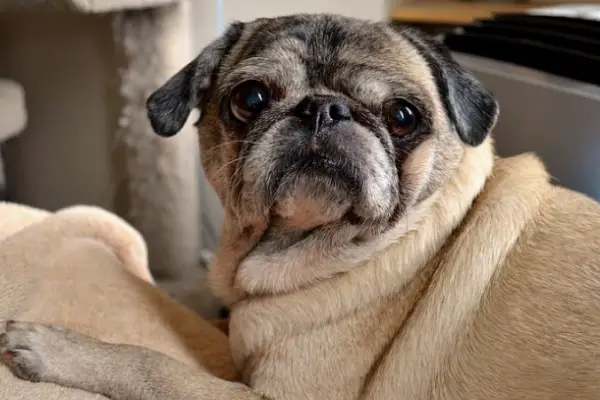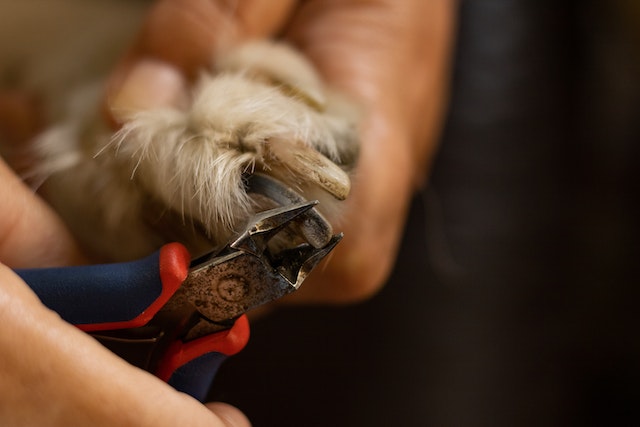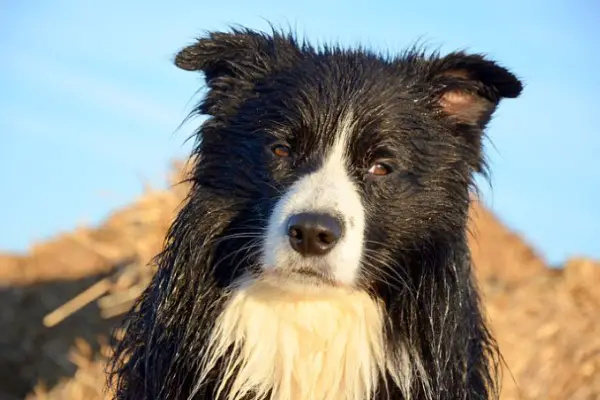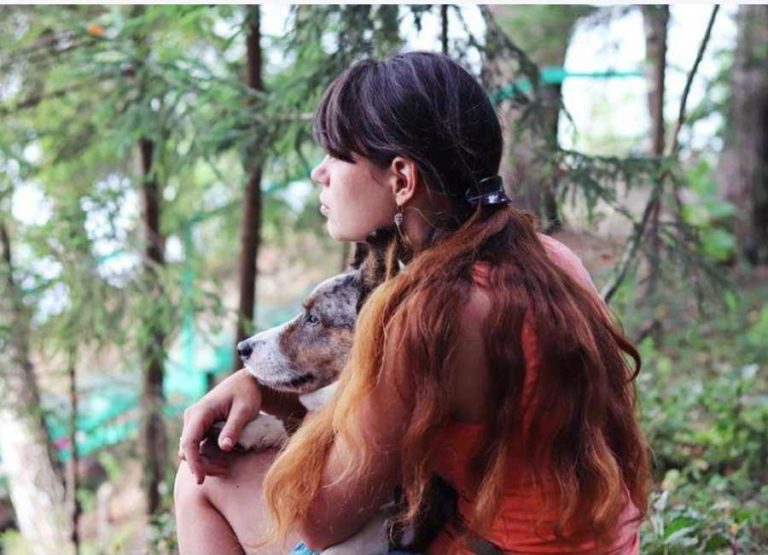Do Pugs Shed a Lot: 9 Shedding Triggers & 9 Control Tips

Every dog sheds, but the question is what is the level of shedding, do pugs shed a lot and what is their level of shedding!
In this post, I will answer your question, I will outline and discuss some common things that may trigger off excessive shedding.
Finally, I will highlight some common ways to tackle excessive shedding in pugs that work, so sit back and read through.
Do Pugs Shed a Lot
Yes, pugs shed year-round, but they shed the most in the spring and fall, with spring having the greatest shedding. As a result, pugs are considered a heavy shedding breed.
While all dogs shed to some level, it is a normal process that preserves their skin and aids in body temperature regulation.
Pugs have a double coat, which causes them to shed more than most dogs.
Excess pug shedding can be reduced with food, grooming, and vitamins, but it cannot be prevented.
The level of shedding in two pugs can differ greatly, even if they are littermates.
Let’s look at why some pugs will shed more than others even though pugs shed generally.
Why pugs shed so much
Poor nutrition, lack of regular brushing, parasite infestations, allergies, and time of the year are the most common causes of excessive shedding in pugs.
Let’s break it down…
The following are some of the most common reasons for excessive shedding in pugs to be aware of:
1. Hormonal fluctuations
We generally understand that hypothyroidism is a hormonal disorder in dogs that results in significant hair loss.
It affects the pug’s thyroid glands, causing a deficiency in thyroxine, a hormone that regulates metabolism.
This sickness causes hair loss, a dull and thin coat, discolored skin patches, fatigue, a lack of enthusiasm for exercise, and weight gain.
If your female pug isn’t spayed, her heat cycles might affect how much fur she sheds at any one time.
You could see her shedding more hair at the end of her cycles.
Hair loss induced by hormone variations encompasses all of these causes of hair loss.
2. Allergies
A pug’s skin may get inflamed and shed because of allergies to particular foods or contaminants in the environment.
As a result of the allergy, your pug may scratch, lick, or bite himself, producing considerable hair loss.
Allergies in pugs can be caused by a variety of things, including food, dust, medication, and insect stings.
A pug’s hair falls out as a consequence of an allergic response on their skin when they come into touch with anything they are sensitive to.
This is an uncommon type of shedding that only happens once in a while. If you find any allergy triggers, keep them out of reach of your pug.
3. Nutritional imbalance
If a pug’s food isn’t balanced, his or her hair will fall off which we call shedding. Pugs suffer from malnutrition in the same manner as humans do.
If you observe any unusually excessive shedding after changing your pug’s diet, switch back or consult a veterinarian, whether it’s winter or spring.
Balanced dog food contains the minerals and vitamins required to maintain healthy skin, strong hair follicles, and minimal discharges.
Omega-3 fatty acids have been proved to help pug dogs produce healthy hair, so including them in their diet is always a good idea.
Dry skin or dehydration can cause undesired hair loss in pugs, thus a moist diet is essential in their existence.
4. Changes in body temperatures
When a pug’s body temperature increases above normal (101 to 102.5 degrees Fahrenheit), excessive shedding should occur.
As a result, do not overwork your pug; a 15-minute daily walk should be enough. If you overwork them in hot weather, you’ll have hair all over your house.
Maintain a watchful eye on their temperature and keep them away from anything that might raise it. Playing with your pug in the heat of the day is a good example.
Because of their size, a rise in body temperature might cause respiratory problems, resulting in a lot of shedding.
5. Parasites infestations
Pugs who go outside can get fleas, mites, and lice, but they shed a lot as a result of the infestation.
One bite from one of these insects can cause a number of issues, including excessive shedding.
Bug bites irritate pugs, and despite the minimal quantity of shedding, this bite may result in shedding.
If your pug is infected with a parasite, she will continue to shed it until the parasite is gone.
As a result, the dog will become irritable and scratchy, resulting in hairless patches in certain cases.
Flea bites in your pug can trigger severe allergic reactions, resulting in excessive shedding, so keep him away from them.
6. Age
Pug pups are said to go through a puppy period between the ages of five and seven months, during which they lose their infants.
However, because older pugs are bigger and have a larger surface area of hair, you might argue that they shed more hair.
Pugs over the age of eight are more likely to develop health issues, which can lead to hair loss.
Pug pups shed a lot more after they outgrow their puppy coat, which happens around four months.
They will then shed copiously until they reach maturity. At old age, shedding excessively on sleeping spots is a pug dying symptom you should look out for.
7. Skin disease or bacterial infections
Skin diseases, bacterial infections, fungal infections, and an infestation can cause significant hair loss in pugs.
These health problems frequently create a lot of pain and contribute to hormonal imbalances, which lead to hair loss.
Bacterial infections such as salmonella can be caught by the consumption of raw foods such as raw chicken.
The problem can be caused by a fungal infection, which can happen if your pug comes into contact with mold or other types of fungus.
Snacks and dry foods can become moldy if not properly stored after each usage.
Keep in mind that pugs are curious dogs that will sniff out whatever they can find in the gaps of your home.
Make sure the locations where your pug spends time are mold-free and that he does not inhale spores on the ground when out for a walk.
8. illnesses
If your pug is unwell, you’ll notice that his or her hair is falling out in clumps more than anything else.
The pattern changes when your pug sheds appropriately. This type of hair loss does not occur in clumps.
It’s important to be aware of this, so you may immediately treat your pug to make him feel better.
Hair loss in pugs can be caused by or worsened by a variety of factors.
Here are a few of the most common pugs health problems that are linked to hair loss:
- Skin diseases
- Kidney disease
- Bacterial infections
- Adrenal issues
- Thyroid issues
- Liver conditions
9. Stress
Pugs shed a lot because stressed dogs lose their hair, and the pugs are no exception.
Changing daily routines or mealtimes can cause stress for pugs, so take note.
Hormonal changes occur often in overworked pugs, resulting in excessive or infrequent discharges.
When things become really interesting, your pug will start tossing hair more regularly for the same reason.
When you go home from work, for example, you see that you have hair all over your body.
As a result, stress-related dog hair loss is invariably connected to pug separation anxiety, depression, and other unpleasant emotions.
Because you can’t entirely prevent pugs from shedding, let’s look at some typical pugs shedding management methods.
Let’s talk solution…
Common ways to control shedding in pugs
Here are the most common and effective ways to control excessive shedding in pugs:
1. Brush your pug regularly
Brushing your pug on a regular basis is one of the most effective methods to remove any stray fur from his coat and keep him from excessive shedding.
Before using a bristle brush, try using deshedding products (such as furminators) and other grooming items specialized for double-coated puppies, such as grooming gloves or mitts.
Brushing once a week should suffice in most cases, but some pugs may require daily brushing to keep their shedding under control. It’s also a good idea to give them goodies throughout the process.
Brush your pug outside and keep in mind that your dog will shed dead hair at any time. For your own sanity, keep the brushing session to fifteen minutes.
2. Avoid stale food and table scraps
Eating table scraps or stale food can cause gastrointestinal distress in pugs, resulting in excessive shedding.
Are you aware that letting your pug eat table scraps on the floor might result in a bacterial infection?
Allowing your pug to eat on the ground is not a smart idea; instead, feed your dog from a clean container.
Allowing your pug to remove food from the table while you’re eating isn’t a smart idea, so don’t allow them.
Pugs’ stomachs are fragile, and if they eat stale food or table scraps, they may vomit, so keep them away from them.
3. Give your pug a bath once in a while
Bathing your pug not only maintains its skin clean but also helps to lower its temperature, which is necessary for shedding.
Request the appropriate shampoo for your pug from your veterinarian, and carefully follow the directions.
After bathing, properly dry your pug’s skin; leaving your pug’s skin to dry on its own will result in skin issues.
Leaving your pug’s skin wet is highly dangerous and can lead to parasite attacks.
Do you realize that allowing your pug to get wet for a lengthy period of time might cause it to stink? As a result, after bathing your pug, make careful to let it air dry.
4. Offer high quality dog food
Feeding your pug a high-quality, nutrient-dense diet can help your pug’s skin and fur stay healthy and avoid excessive shedding.
Apples, bananas, grilled salmon, and mango are some fantastic human snacks to include in their diet (in moderation).
Remember to keep their water dish kept up and replenished since hydration is essential.
Feed your pug a well-balanced diet to ensure that even the tiniest hair shedding on the inside is kept to a minimum.
5. Avoid dehydration
Your pug should always have access to clean drinking water to avoid dry skin, which also helps to lower your pug’s body temperature.
This is important because dogs who don’t drink enough water have dry skin and hair, which leads to excessive shedding.
If your dog’s water dish is maintained clean and full, the risk of harmful microorganisms being consumed is decreased.
Keep an eye on your dog’s water bowls to ensure that they are only drinking clean water.
Not only may dehydration cause health issues, but it can also cause shedding.
As a result, make sure your dog has access to fresh water at all times.
Try one of the following approaches if you’re having trouble encouraging your dog to drink enough water:
- Water should be added to their meal.
- If Ice cubes are available, give them some cubes.
- When they drink, give them a gift and congratulate them.
- Place their water bowl near their bed or a favorite hangout spot.
6. Add supplements to your pug food
You may complement your pug’s diet with vitamins to guarantee a healthy coat, in addition to providing nutritious dog food and treats.
Look for linoleic acid, flaxseed oil, and omega 3 fish oils in supplements (sometimes called omega fatty acids).
Omega 3 fish oils are particularly beneficial for keeping your pug’s coat and skin healthy, as well as avoiding hair breaking, which can cause them to shed more than usual.
7. Avoid allergies
One of the most important things you can do to prevent your pug from shedding excessively is to do this.
A pug’s allergic reaction might be triggered by a number of things. Allergies to pollen, mold spores, mites, and dead skin cells are common.
Food allergies, on the other hand, might cause skin problems or hair loss in your pug, so keep a lookout for these conditions.
8. Avoid parasite infestations
Whether it’s fleas, worms, or ticks, preventing shedding in pugs is critical.
External irritants, like fleas, ticks, and allergies, can occasionally cause pugs to shed.
Keeping your pug as safe from these irritants as possible might help prevent shedding that isn’t essential.
Allergies may be tested, treated, or controlled under veterinarian care, and flea and tick collars are effective and easy.
9. Schedule regular medical check-ups
This is an important step to take when evaluating how to prevent pug shedding because shedding can be caused by a multitude of health conditions.
Always seek advice from your veterinarian and have your pug evaluated on a regular basis.
I hope the information provided on this page answered your question do pugs shed a lot!




![How Long Should Dog Nails Be [Detailed Answer] How Long Should Dog Nails Be](https://petcreeks.com/wp-content/uploads/2023/09/dog-4369608_640.jpg)

